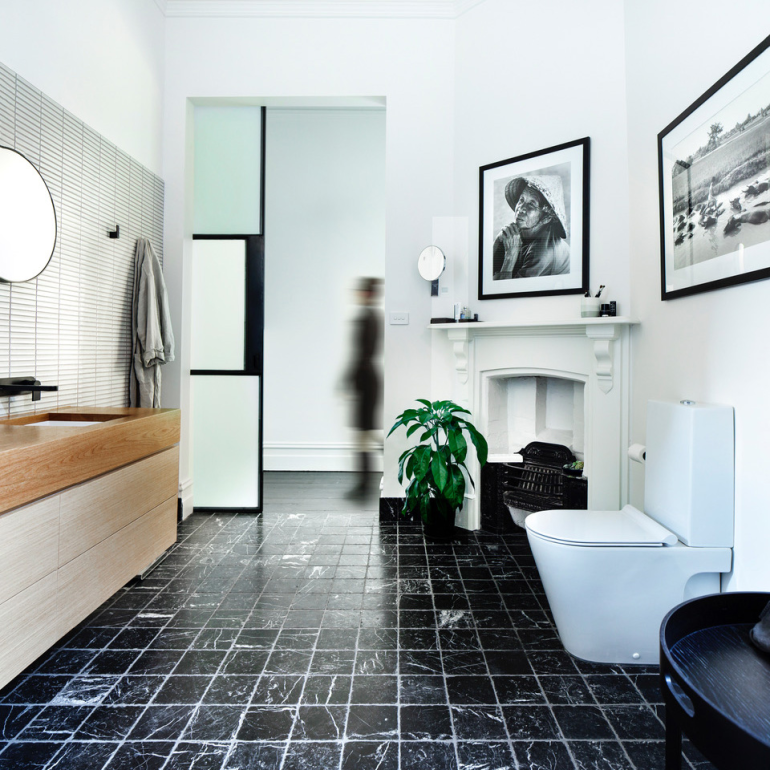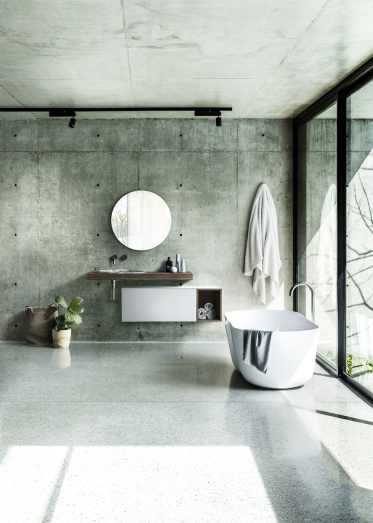
South Yarra bathroom by Hearth Studio featuring Featured Products — Fantini Mare tapware & shower, Catalano Zero Monobloc toilets and Vitra Memoria basin. Photograph by Ross Tonkin
In our day-to-day lives the bathroom is seen as a space for rejuvenation – a retreat from the outside world where we discover a fresher, cleaner version of ourselves. It is also a space to treat yourself, though the need to be sustainable has changed the way we think about the products we use. Looking beyond water-saving shower heads and solar power, a range of new materials is emerging that do more than help the environment – they also improve our health and quality of life.
Italian company Catalano has been producing ceramic bathroom products since 1967 and 50 years on it is at the centre of the holistic bathroom movement. Its engineering and manufacturing processes are now leaving a lighter footprint from the factory to your floor.

A detail of the high gloss Cataglaze finish.
Its glazing technology, Cataglaze, stems from a philosophy of creating sustainable products and, unlike traditional glazing, it is applied before a product is finished. This means it doesn’t deteriorate over time, but lasts as long as the ceramic itself. Investing in a product that will last a lifetime is one take on sustainable luxury, though the Cataglaze technology provides some added benefits.
We would all like to think our bathrooms are a pristine sanctuary and on the surface they may be – though behind the bath salts and aromatherapy they are actually home to all forms of bacteria and keeping these nasties at bay generates significant waste. Cataglaze is ideal for those looking for a material with a perfectly smooth surface that is 100 percent bacteria proof and easier to maintain than more porous surfaces, such as natural stone. Ultimately, this reduces the amount of detergent and water required to keep things clean – saving time, money and the environment.

Bathroom featuring Falper timber and Ceramilux.
Another Italian development, Ceramilux, offers an alternative to ceramics. An engineered composite, it blends natural materials with resin to offer designers endless possibilities in customising vanities and bathware through manufacturers such as Falper. Soft to the touch, it can be injection moulded, so there are no joins that can yellow, or welds for bacteria to penetrate, and the recyclable surface is burn resistant.
Similarly, a PVD (Physical Vapour Deposition) coating for bathroom hardware – think taps and shower heads – brings a layer of protection, heat resistance and durability to those items we touch every day. Applied to a selection of Fantini products, the process is free from hazardous materials and thus the manufacturing process is environmentally friendly.
These touch points don’t all have to be cold and hard though – the warmth of timber also has its place in the bathroom, as long as it is treated correctly.

Aboutwater tap ware by Naoto Fukasawa finished in Fantini PVD.
Falper, another Italian firm, uses a styrene-free timber veneer in its range of baths and vanities. Combined with Ceramilux, the mix creates something a little more homely and tempting. With a water-repellent treatment applied to the surface, it is now possible to create a connection to the rejuvenating feel of nature without the potential of timber warping or mould occurring.
More than just green washing, these new approaches to a holistic bathing environment complement more traditional materials like glass and marble, while adding value to your home, your life and to our environment.
Images courtesy Rogerseller
WRITTEN BY HouseLab









